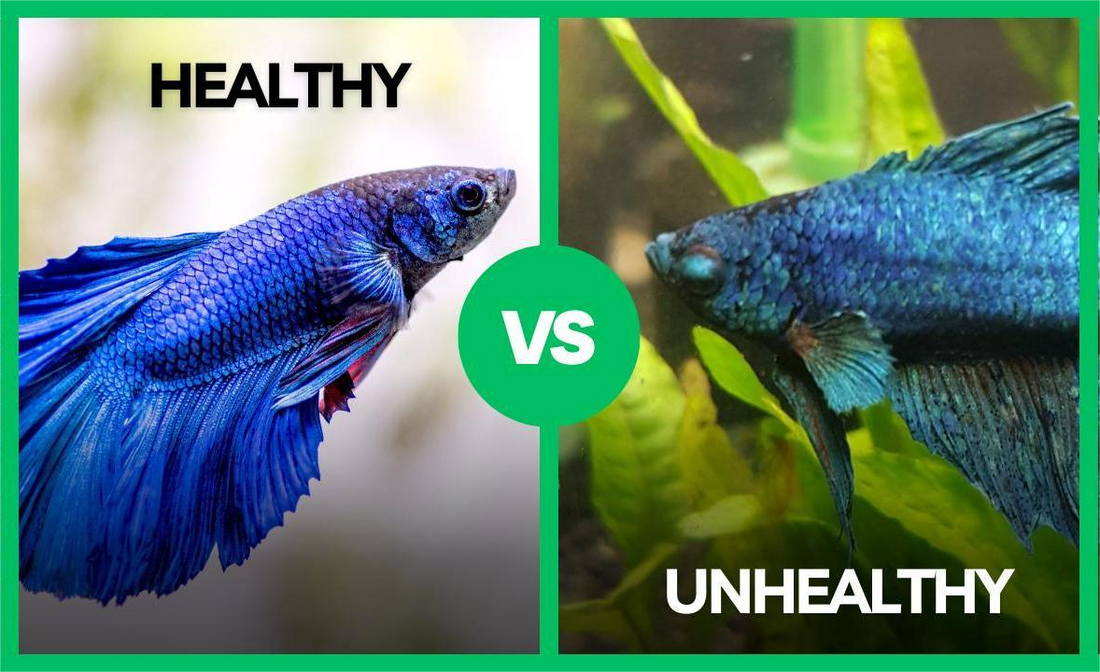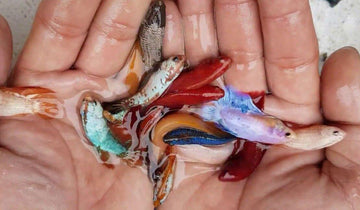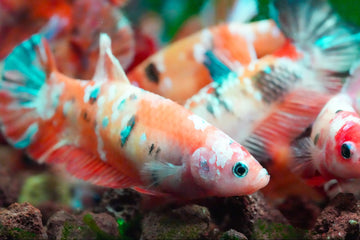Spotting the Differences Between a Healthy vs. Unhealthy Betta Fish

Contents
When it comes to caring for your betta fish, it’s important to know how to spot whether they’re healthy or not.
A healthy betta is usually bright, active, and full of personality, while an unhealthy one might show some signs that things aren’t right.
By learning to recognize these differences, you can take better care of your fish and help them live a longer, happier life.
Signs of a Healthy vs. Unhealthy Betta Fish

We’ll look at the telltale signs to help you tell if your betta is doing well or if it needs some extra attention.
|
Feature |
Healthy Betta |
Unhealthy Betta |
|
Coloration |
Bright and vibrant |
Dull or faded |
|
Activity Level |
Active and curious |
Lethargic and inactive |
|
Eating Habits |
Eagerly eats food |
Refuses food |
|
Fin Appearance |
Intact and flowing freely |
Clamped or damaged |
|
Swimming Posture |
Upright and balanced |
Floating sideways or at the bottom |
|
Physical Symptoms |
No visible lesions |
Swollen abdomen; mucus discharge |
1. Coloration
Healthy Betta:
One of the first things you’ll notice about a healthy betta is its stunning color.
Whether it’s deep blues, bold reds, or shimmering greens, a healthy betta’s colors are bright, radiant, and almost seem to sparkle under the aquarium light.
Healthy bettas appear full of life, and their vibrant hues are a result of proper nutrition, good water quality, and a stress-free environment.
Bettas naturally display their beauty when they feel good, and their scales often have an iridescent sheen, reflecting light beautifully.
Unhealthy Betta:
A dull, faded color is often a telltale sign of a problem.
If your betta’s once-vibrant colors seem washed out or pale, this might signal stress, illness, or poor water conditions.
Stress from an overcrowded tank, improper water temperature, or a sudden environment change can cause a loss of color.
In more severe cases, illnesses like bacterial infections may also cause the betta’s scales to look lifeless, and patches of white or gray can appear.
2. Activity Level
Healthy Betta:
A healthy betta is an active swimmer, always moving around its tank and showing curiosity about its surroundings.
You’ll often find your betta exploring plants, decorations, or even investigating its reflection. It may even swim up when it sees you, eager to interact or anticipating feeding time.
This level of activity is a great indicator of your betta’s overall well-being, as they are naturally curious fish.
Unhealthy Betta:
An unhealthy betta, on the other hand, may appear lethargic or inactive, which may indicate an infection, swim bladder issues, or improper water conditions.
The symptom might include:
- Long periods of motionless floating or lying at the bottom.
- Avoiding interaction or retreating behind plants or decorations.
- Gasping for air at the surface due to potential gill problems or poor water oxygen levels.
A betta that isn’t swimming as it used to definitely needs further attention.
3. Eating Habits
Healthy Betta:
Healthy bettas are known for their hearty appetites. They should quickly swim to the surface as soon as food hits the water, eagerly snapping up pellets, bloodworms, or brine shrimp.
A good feeding schedule and the right type of food—such as high-quality pellets, frozen or live brine shrimp, or bloodworms—will keep them satisfied and energetic.
A healthy fish’s enthusiasm for food is a clear sign that its digestive system is working well, and it’s getting the nutrition it needs.
If your betta eagerly eats its food and is always ready for the next meal, this is a great sign of good health.
Unhealthy Betta:
If your betta fish starts refusing food or seems disinterested in eating, it’s usually a red flag. A healthy fish shouldn’t ignore food for more than a day or two.
Illnesses like constipation, bacterial infections, or parasitic issues can cause a lack of appetite. Additionally, poor water quality can discourage a fish from eating.
If your betta isn’t eating for more than a couple of days, it’s time to look deeper into what might be wrong and act quickly.
4. Fin Appearance
Healthy Betta:
A healthy betta’s fins are one of its most stunning features. These fins should be long, flowing, and spread out naturally as the fish swims.
Bettas, especially males, are known for their impressive fins, and when they’re in good health, these fins move smoothly and look vibrant.
Your betta’s fins are more than just for show—they are a sign of good health.
If you notice your betta flaring its fins, that’s a good sign of confidence and energy, showing that it’s feeling good about its environment.
Unhealthy Betta:
Unhealthy bettas often have fins that look clamped or damaged.
Clamped fins—where the fins are held tightly against the body—are a common sign of stress, illness, or poor water quality.
Infections like fin rot can also cause the fins to become ragged, torn, or discolored.
Look out for these signs:
- Frayed, torn, or ragged edges.
- Discoloration or fin rot (white, black, or red edges).
If your betta’s fins appear damaged or start to rot, it’s essential to act quickly. Improve the water conditions and look for treatments specifically designed to help with infections.
5. Swimming Posture
Healthy Betta:
A healthy betta fish will swim upright with a natural, balanced posture.
You should see your betta swimming upright, gliding smoothly through the water with its fins fully extended.
Bettas are known for their graceful swimming style, often darting around the tank but always in control of their movements.
They also have a unique organ called the labyrinth, which allows them to breathe air from the surface.
You may see them swim up to take a gulp of air before returning to swim normally, which is completely healthy behavior.
Unhealthy Betta:
If you see your fish floating on its side, sinking to the bottom, or having trouble staying upright, it might have swim bladder disease.
The swim bladder is what helps fish stay afloat, and when it gets infected or inflamed, they can struggle to swim correctly.
However, there are other reasons your fish might be swimming oddly, like stress or injury. So, it's important to keep an eye out for any unusual swimming behavior.
6. Physical Symptoms
Healthy Betta:
A healthy betta will have smooth, clear skin with no visible lesions or wounds.
Its eyes should be bright, and its body should look sleek and free from any visible issues.
Occasionally, you may notice a thin, clear slime coating on the betta’s body, which is completely normal.
This natural slime helps protect the fish from infections and other health problems.
Unhealthy Betta:
There are a few physical symptoms that can show your betta is sick, including:
- A swollen belly, which might mean constipation or something more serious like dropsy, a condition that causes internal swelling.
- Raised scales that give the fish a “pinecone” look, which is a classic sign of dropsy.
- White spots on the body, often a sign of ich, a common parasite.
- Extra mucus on the body, which can mean an infection.
- Open wounds or sores, suggesting injury or disease.
If you notice any of these symptoms, it's important to start treatment right away.
Handling a Sick Betta Fish
Bettas can get sick in different ways, like swim bladder issues, parasites, or internal infections. Each illness has its own signs, and knowing what to look for can help you figure out the best treatment.

If you think your betta is unwell, it’s a good idea to separate them from other fish or creatures in the tank. This helps stop the spread of illness or parasites. Using a separate treatment tank also lets you give medication without messing up the main tank’s water balance.
Tips to Keep Your Betta Fish Healthy
Keeping your betta fish healthy is all about prevention. Here are some easy tips to help ensure your fish stays happy:
- Change part of the tank water regularly—about 25-50% each week. Use a water conditioner to get rid of harmful chemicals like chlorine.
- A quality filter keeps the water clean and oxygen-rich. Just make sure the flow isn’t too strong since bettas prefer calmer waters. A sponge filter or an adjustable one can be a good fit.
- Bettas do best in a stable environment. Aim for a water temperature between 76°F and 82°F (24°C to 28°C), and consider using a heater if needed.
- Provide high-quality pellets made for bettas, and mix in occasional treats like frozen or live foods (like brine shrimp or bloodworms). Don’t overfeed, as this can lead to tummy troubles.
- Keep stress levels low by avoiding loud noises, sudden movements, and bright lights. Adding plants or decorations can give your betta places to hide and feel safe when they need a break.
- If you’re bringing in new fish or plants, quarantine them for at least two weeks to make sure they’re healthy. This helps keep your current fish safe from any diseases.
Check Out Our Selection of Betta Fish at Tropicflow

At Tropicflow, we love helping you find the perfect betta fish for your home! Our catalog features a wide range of colorful and healthy bettas, each with its own unique personality.
Whether you’re just starting out or you’re a seasoned fish keeper, you’ll find something you love in our collection.
Visit us at Tropicflow and let us help you create an amazing aquarium!
No comments











0 comments